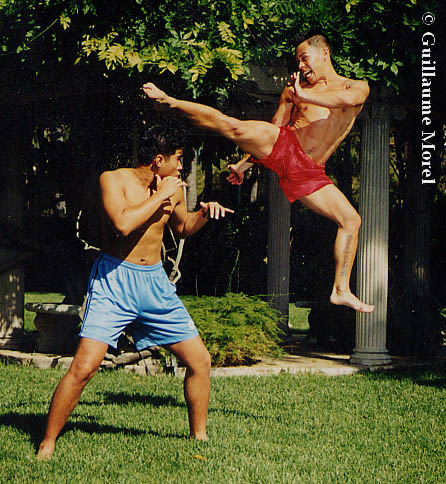|
|||
|
| -Countries |
| -Dictionary |
| -Federations |
| -M.A. Timeline |
| -Number System |
| -Styles |
| -Weapons |
| -Who's Who |
| -Updates |
| -Credits |
| -Stats |
| -Webmaster |
| Ernie Reyes Jr.
What would you say of a 50-pound boy who entered the American professional karate ranks in the adult division and in his first year in the sport at age 8 became the first and only child ever to achieve a national Top-10 ranking? Ernie Reyes, Jr. did just that and went on to improve his national ranking for two more consecutive years, from 10th to 6th to 4th. Ernie made karate history again when, at age 10, he became the first and only child ever to win a Grand Champion title at a national karate tournament. Ernie Reyes, Jr. began his life in San Jose, California, where his father, Ernie Sr., was a dedicated and traditional teacher of the martial arts with a loyal following. Beginning his foray into the martial arts at 19, by age 33 Ernie Sr. had won the American National Championship and placed 3rd in the World Championships (Tae Kwon Do), and was already a member of the Karate Hall of Fame. It was in this atmosphere that Ernie Jr. was introduced to the sport. He was to prove to be a quick study--the quickest in history, in fact. Growing up, Ernie Sr. had a profound influence on young Ernie. According to Ernie Jr. the lessons he learned from his father transcended the pure physical expression of martial arts talent. As he told an interviewer from Inside Kung Fu magazine: "My dad has taught me everything I know, both about martial arts and life. But it's not like he sat me down one night in a blowing wind and said, "Young Grasshopper,..." And what he said was not always at me. I would hear him tell other students what it's really about, you know, respect and discipline."
When Ernie was 13 he got his first introduction to Hollywood by way of show business luminaries Berry Gordy and Suzanne DePasse. They had already set the cast for The Last Dragon, a Motown/Tri Star Productions project, but were not pleased with the level of martial arts skills. They called on the West Coast Demonstration Team in order to get some better ideas. After witnessing Ernie's incredible skills, Berry Gordy exclaimed "I know talent when I see talent, and this kid's got talent!" They immediately took a break from the demonstration, booted up the computer, and created a role in the movie for Ernie and wrote him into the script right there on the spot! After the filming of The Last Dragon Berry and Suzanne created another project which was tailor-made for Ernie, called The Last Electric Knight, which would be a Disney/Motown collaboration. This was the Movie of the Week written specifically to set up a new TV series in which Ernie would star along with his crime-fighting partner, Gil Gerrard. When the head of Disney, Jeffrey Katzenberg, first met Ernie and saw him perform he remarked "This kid is a one-of-a-kind!" Soon after that, both he and Mickey Mouse were personally introducing Ernie and The Last Electric Knight on national television in order to better guarantee the success of the show and its upcoming spin-off TV-series, Sidekicks. However, after Dragon had completed filming and before Knight
had started, Ernie was called to the Beverly Hills Hotel to
audition for Dino De Laurentiis, Rafaella De Laurentiis, and
Mary Jo Slater for a role in Red
Sonja, starring Arnold
Schwarzennegger and Brigitte
Nielsen. Apparently, they were looking for a young man with
the qualities and ability to carry the role of an 8-year old
prince, and even though Ernie was already 12, his diminutive
body would easily fit the bill. The auditioners were in for a little surprise, however, as they had no idea of Ernie's enormous prowess as a professional athlete and martial artist. When Ernie unexpectedly cut loose with a blazing torrent of moves, kicks and jumps they were electrified and, as Ernie recalls, "got really excited and began speaking Italian really fast!" He was immediately signed and the script was rewritten to accommodate Ernie's talents. After Dragon, Red Sonja, and Electric Knight had hit the market and the Sidekicks series was underway, Ernie was really on the map. He began to do guest-star roles in other shows such as McGuyver, Highway to Heaven and Kung Fu, and also became a series regular Circus of the Stars where he performed for five years as a circus daredevil in acrobatics, on the highwire, and on the trapeze--and it was probably about this time that the concept of "martial arts movies for kids" began to take shape, crystallized by a charismatic man-child artist-athlete named Ernie Reyes, Jr. Golden Harvest, who had done all the Bruce Lee and many of the Jackie Chan films, was doing a zany new project called Teenage Mutant Ninja Turtles. The stunt coordinator was Pat Johnson (The Karate Kid, Mortal Kombat), and the martial artists (in Turtle costumes) were four of the best from Hong Kong. When one of the Turtles injured his back in a stunt, Pat knew that there was really only one guy who could step in and pull off the demands of the job, someone whom he had known for ten years: 17-year old Ernie Reyes, Jr. Ernie accepted the job, and for the first time in his life found himself away from home on his own, doing his own thing, free of the hectic, jam-packed pace which had dominated his young life for so many years. And he liked it--not that the conditions were all that wonderful: wearing a full-body, 35-pound rubber-latex Turtle-suit all day in hot and humid South Carolina in the middle of summer--and having to do continuous strenuous martial arts feats which boosted up the inside temperature even further!
Looking back, Ernie said that when they were in production on Turtles II he knew that he was part of something big. "You know, when you do something, and you know it's going to be a hit...I've been in a hit, and I've been in a bomb, and I know the difference." After Turtle II's $25 million opening weekend he got a call from New Line Cinema with a simple message from Sarah Risher: "We want to do movies with you!" Ernie soon after agreed and signed a deal to star in and associate-produce New Line's Surf Ninjas, also starring Leslie Nielsen. Even though Ernie was active in his new career in show business, in between movies and TV shows he was still regularly touring the country with the West Coast Demonstration Team, participating in weekly karate tournaments, and as it turns out, building one of the most remarkable fan-bases in the country. Every week Ernie was getting more well known throughout America and the world. He would appear with the Demo Team at telethons, schools, tournaments, malls, television specials, at professional football, baseball, and basketball games, at car shows, in Las Vegas and Reno casinos, on network morning television shows, and regularly appeared on the covers of every single karate magazine in America and the rest of the world. Whenever Ernie would arrive for an event at a school or mall or virtually anywhere he went to perform, literally every kid would already know who he was, and he would just be swarmed over by a sea of young admirers. More often than not the kids would just begin chanting "ER-NIE!! ER-NIE!! ER-NIE!!" before, during, and after the show. Even to this day, wherever he goes and there is a gathering of kids, each kid inevitably knows who he is. Reflecting back at his touring times, Ernie estimates that he has signed probably on the order of hundreds of thousands of autographs for his fans. There were times when he would do nothing else for 10-12 hours at a stretch, breaking only to get something to eat. This kind of "road show" went on week-in and week-out year after year for over a decade. His personal appearances merely accelerated what was happening to him in show business. Ernie was a popular young man! When it came time for principal photography on Surf Ninjas the director had not yet been introduced to Ernie's blinding speed as a martial artist, and insisted that his fight scenes be filmed at 20 frames per second, to be played back at the normal 24, speeding up the movement. He reasoned that since all other top martial artists, including Jackie Chan, routinely filmed their fight scenes in this fashion Ernie would be no different. One day of dailies cured him of that notion--Ernie was a cinematic blur! Surf Ninjas came off as planned, but the 98% "Good to Excellent" ratings from the screening audiences never materialized at the box office, possibly due to marketing choices. Despite the movie's poor performance, Ernie got a close-up, firsthand look at the whole movie-making process, and managed to come away with the personal certainty that he had what it took to successfully wear the other major hats in the filmmaking process--writer, producer, and director--and create a good product. Ernie's favorite movie stars at the time were Marlon
Brando, Al
Pacino and Robert
De Niro. Not knowing how much positive influence he could
exert over the destiny of any film purely as an actor, Ernie
asked himself honestly if he thought he could compete artistically
with his idols, and the answer was a definite "No."
Disenchanted with the success of Surf Ninjas, Ernie did one
more project, Cry of the White Wolf II--Legend of the Wild,
before beginning his withdrawal from the "front lines"
of show business and commencing his own personal search for
artistic excellence--almost going into hiding. He walked away
from the money, the lifestyle, and the adulation in order to
find out what it was like to really be an artist. According
to Ernie, this turning point was the best thing that could have
happened. A close friend had been harping on him for some time to come meet "this amazing teacher," and Ernie finally consented to make the journey to one of his classes. As Ernie describes: "When I heard him speak I was so freed by what I was hearing--that you, the artist, are the decision-maker that creates any reality you want, and that in order to be an artist you cannot be detoured by any outside influence--that I just wanted to move away right then. I was ready to just skip and chill-out and go to a desert island and read plays and books and be happy! I said to myself 'Oh, my God, I'm about to move into a whole new level of art.'" The teacher was Broadway and film-star, Actors Studio senior member, award-winning actor-director-producer and professional coach, Manu Tupou--one of the most studied scholars and researchers of the dramatic arts in the world today. And Ernie has been a devoted student, protégé, and collaborator ever since they met. Really learning the art "from the ground up" and feeling a fresh sense of certainty, Ernie gravitated back into the Hollywood groove and once again began appearing in television shows and movies. He guest-starred in High Tide, FX, and Pacific Coast Highway on TV, and played the leads in Paper Dragon, Small Time (Best Film--1995 Santa Barbara Film Festival), and his latest project, The Process, in which he also co-wrote (with Manu), starred-in, directed and edited. Noteworthy of Ernie's work in The Process is that, while both directing and starring at the ripe-old age of 23, he brought in the film in only 12 days on a budget of $50,000. Says Ernie: "Working under what were extremely difficult conditions in a foreign country (Canada) I was still confident that I could make everything go right--I knew that I could make it happen, and I did." After The Process, Ernie and Manu collaborated again, this time on a dynamic new martial arts stage show with a real story-line and a Broadway-class presentation, called Unleash the Master Within. The show was produced in San Jose, California, recently acknowledged as the finest regional theater center in the world. Ernie starred as the lead actor, co-wrote the script, was co-artistic director, and even wrote one of the songs for the one-night-only pilot production. The sold-out show was a spectacular success, with the crowd of 3,000 giving Ernie and the cast a roaring 10-minute standing ovation. When questioned about his goals Ernie says "I just want to be the best that I can, and reach my full capacity physically, mentally, and spiritually." In keeping with that philosophy, and in addition to his artistic demands, Ernie has remained true to his first calling, the martial arts, and works out religiously virtually every day of his life. He has also recently taken on the demands of adding boxing and Thai kickboxing to his repertoire. As has been the case with everything else he has undertaken, Ernie proved once again to be an fast learner. After sparring with Sugar Ray Leonard, the former world welterweight champion told him "Don't let anybody tell you you can't do it because you can (make it to the top of the boxing world)--what you lack in experience you make up for in talent." Said former world heavyweight champion Ken Norton's trainer, Bill Slayton, of Ernie's prowess: "He's a featherweight, but punches like a welterweight" (a 20-pound weight differential). Ernie's Thai Boxing (the most lethal form of kickboxing) instructor, Saekson Janjira, 6-time world champion and ranked #2 in Thailand, also shares sentiments with Ernie's other instructors: "I have never had another student that could pick it up as fast as you (Ernie)." As an amateur with only two months' training behind him Ernie won his first two Thai Boxing fights by knockout--the first victory coming over the California amateur champion, and the second over the reigning professional world champion, a truly incredible feat which has never been accomplished by anyone else before him. Being the prodigy and champion that he is, showcased in movies and television, and being featured in more martial arts magazines more times than anyone in history other than Bruce Lee, Ernie has a huge latent fan-base merely waiting for the signal to vault him to the top. For starters, there is probably not a single martial arts enthusiast in the world over 12-years of age who does not know who Ernie is and consider themselves a fan. This is something on the order of 10 million martial artists world wide, and probably another 25+ million kids and young adults in America alone who know him just from his movies and television shows. In the Philippines, he is the biggest star around, and has a huge following throughout the rest of Asia. Check out Ernie Reyes Jr's webpage.
|

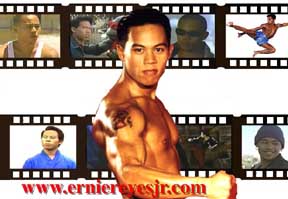
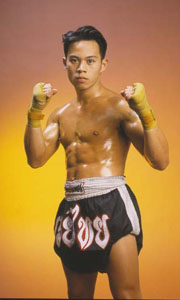 The
"other students" were the other members of the "
The
"other students" were the other members of the "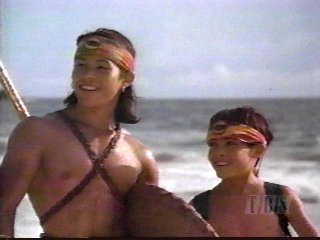
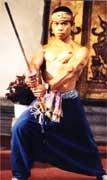 Ernie
made such an impression even in his non-speaking role as Turtle
Donatello, that during filming one of the executives at Golden
Harvest, Tom Grey, took him aside and told him that there would
definitely be a sequel and that he would definitely be written
in no matter what. As it turned out
Ernie
made such an impression even in his non-speaking role as Turtle
Donatello, that during filming one of the executives at Golden
Harvest, Tom Grey, took him aside and told him that there would
definitely be a sequel and that he would definitely be written
in no matter what. As it turned out 